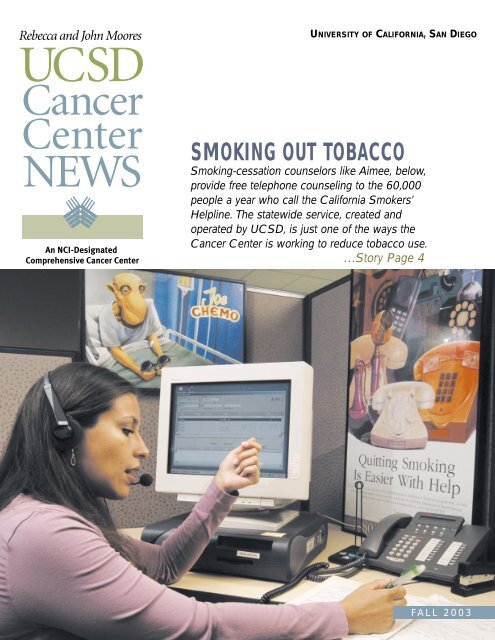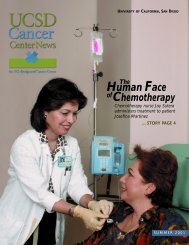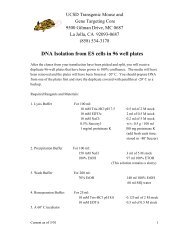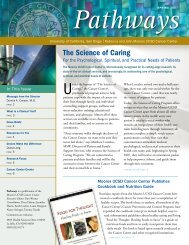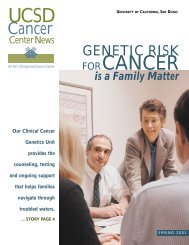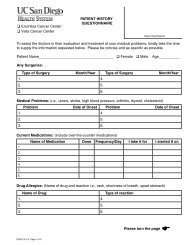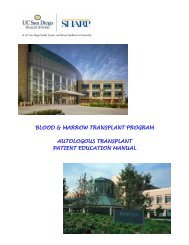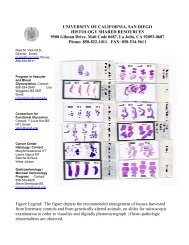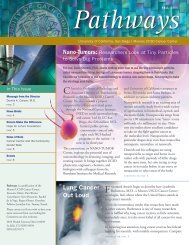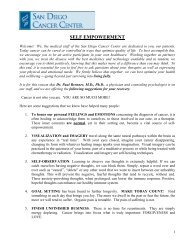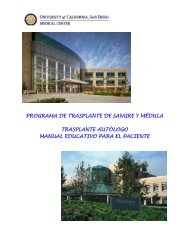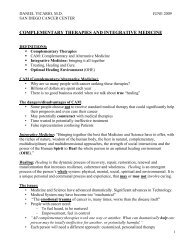SMOKING OUT TOBACCO - Moores Cancer Center
SMOKING OUT TOBACCO - Moores Cancer Center
SMOKING OUT TOBACCO - Moores Cancer Center
Create successful ePaper yourself
Turn your PDF publications into a flip-book with our unique Google optimized e-Paper software.
UNIVERSITY OF CALIFORNIA, SAN DIEGO<br />
<strong>SMOKING</strong> <strong>OUT</strong> <strong>TOBACCO</strong><br />
Smoking-cessation counselors like Aimee, below,<br />
provide free telephone counseling to the 60,000<br />
people a year who call the California Smokers’<br />
Helpline. The statewide service, created and<br />
operated by UCSD, is just one of the ways the<br />
<strong>Cancer</strong> <strong>Center</strong> is working to reduce tobacco use.<br />
…Story Page 4<br />
FALL 2003
UCSD <strong>Cancer</strong> <strong>Center</strong> Foundation<br />
PRESIDENT OF THE FOUNDATION BOARD<br />
Cinda K. Lucas *<br />
OFFICERS<br />
Gordon P. Boerner *<br />
Marilynn Boesky *<br />
Howard I. Cohen *<br />
William T. Comer, Ph.D. *<br />
Frank M. Goldberg *<br />
Charles F. Gorder Sr., Esq. *<br />
Mary Rand Taylor *<br />
John McDonnell *<br />
BOARD OF DIRECTORS<br />
J. Samuel Armstrong, IV<br />
Terry Ash<br />
Kathryn A. Bernert, Esq.<br />
Howard C. Birndorf<br />
Sophie Brody<br />
Deborah J. Case<br />
Carol L. Chang<br />
L. Reneé Comeau<br />
Jay de Groot<br />
Charles Faith<br />
Yehudi Gaffen<br />
Howard Goldfeder*<br />
Donald W. Grimm<br />
Ernest Huang, Ph.D.<br />
Al Hugo-Martinez<br />
Jacqueline Johnson, Ph.D.<br />
Maurice C. Kaplan, Esq. *<br />
Jerome S. Katzin, Esq. *<br />
Jeffrey Lipinsky<br />
George L. Liggins,<br />
M.P.H., Ph.D.<br />
Joany Mosher<br />
Alex M. Nadzan<br />
Henry L. Nordhoff<br />
Carrie O’Brien<br />
Anne S. Otterson<br />
John W. Otterson, II<br />
Kenneth D. Polin, Esq.<br />
Kimberly Simpson Querrey<br />
Edward T. Shonsey<br />
ADVISORY BOARD<br />
John R. Bonn, Esq.<br />
Diane Clarke<br />
Lois J. Crandell<br />
Audrey S. Geisel<br />
George L. Gildred<br />
Irwin Jacobs, Ph.D.<br />
Richard Levi<br />
Art Lujan<br />
Marianne McDonald, Ph.D.<br />
John H. Moxley III, M.D.<br />
Peter Preuss<br />
Clayton D. Pruett<br />
Ruth L. Schulman<br />
John Walton<br />
Walter Zable<br />
EX OFFICIO MEMBERS<br />
Edward W. Holmes, M.D.<br />
Robert Horsman<br />
Katherine Kennedy<br />
Sam Iacobellis, Ph.D.<br />
Esther R. Nahama<br />
Tom Nielsen<br />
Rebecca Newman<br />
INTERIM DIRECTOR, MOORES<br />
UCSD CANCER CENTER<br />
Gordon Gill, M.D.<br />
DEPUTY DIRECTOR,<br />
CLINICAL OPERATIONS<br />
David W. Easter, M.D.<br />
DEPUTY DIRECTOR,<br />
RESEARCH OPERATIONS<br />
Thomas J. Kipps, M.D., Ph.D.<br />
ASSOCIATE DIRECTOR FOR<br />
ADMINISTRATION<br />
Ira S. Goodman<br />
DIRECTOR OF DEVELOPMENT<br />
Sarah Godfrey<br />
ASSOCIATE DIRECTOR OF<br />
DEVELOPMENT<br />
Martha Shumaker<br />
DEVELOPMENT ASSISTANTS<br />
Carlos Castaneda<br />
Christa Collins<br />
Maryann Lapthorn<br />
* Officers and Members of the Executive Committee<br />
<strong>Moores</strong> UCSD <strong>Cancer</strong> <strong>Center</strong> News is a publication of the<br />
UCSD <strong>Cancer</strong> <strong>Center</strong> Foundation. Comments are welcome.<br />
UCSD <strong>Cancer</strong> <strong>Center</strong> Foundation<br />
9500 Gilman Drive MC 0658<br />
La Jolla, CA 92093-0658<br />
(858) 822-0022<br />
Executive Editor: Sarah Godfrey • Editor: Nancy Stringer<br />
Contributing Writers: Sarah Godfrey, Sarah Lifton, Nancy Stringer<br />
Cover Photo: Dave Siccardi • Design: Janice Gordon<br />
Message<br />
from the<br />
Director<br />
You may have noticed that this<br />
issue of the newsletter is coming<br />
to you a little later than usual.<br />
We delayed production in order<br />
to bring you exciting news —<br />
UCSD has named a new director<br />
for the <strong>Cancer</strong> <strong>Center</strong>.<br />
It is my distinct pleasure to<br />
introduce Dennis A. Carson, M.D., an internationally known and<br />
respected immunologist and cancer biologist who has been a<br />
senior member of the UCSD faculty since 1990. I have known<br />
Dr. Carson for many years as a brilliant scientist, and an effective<br />
and energetic leader.<br />
Featured in this issue is a conversation with the new director<br />
that I hope you’ll take a moment to read so that you might get<br />
to know a little more about him.<br />
Over the last several weeks, Dr. Carson and I have worked<br />
closely together to ensure a smooth transition of leadership.<br />
I know that I’m leaving the director’s office in the best possible<br />
hands.<br />
And so this becomes my farewell message.<br />
It has been a pleasure to serve as the interim director since<br />
January of this year. During that time we have made progress<br />
in important areas, including bringing new faculty on board in<br />
key positions, strengthening clinical services, and establishing<br />
the first of several major programs that we refer to as “centers<br />
of excellence.” Our first center of excellence is in hematologic<br />
malignancies, led by Dr. Thomas Kipps. You will hear more<br />
about this exciting, multifaceted program and others to follow<br />
in future issues of the newsletter.<br />
As my service comes to a close, I would like to take this opportunity<br />
to extend my thanks to the hundreds of faculty and staff<br />
who make up the <strong>Cancer</strong> <strong>Center</strong> family. I am profoundly grateful<br />
for their generosity of spirit and their good counsel during my<br />
tenure as interim director.<br />
Please join me in welcoming Dr. Carson and in supporting<br />
him as he leads the <strong>Cancer</strong> <strong>Center</strong> in the coming years. Thanks<br />
to the dedication of the faculty, staff and community partners<br />
like you, we will continue to move closer to the day when we no<br />
longer have to worry about cancer as a life-threatening disease.<br />
Sincerely,<br />
Gordon Gill, M.D.<br />
Interim Director,<br />
<strong>Moores</strong> UCSD <strong>Cancer</strong> <strong>Center</strong><br />
<strong>Cancer</strong> <strong>Center</strong> News<br />
2
UUCSD officials and major donors recently signed<br />
one of the final steel beams to be used in the construction<br />
of the Rebecca and John <strong>Moores</strong> UCSD<br />
<strong>Cancer</strong> <strong>Center</strong> building. Afterward, guests at the<br />
“Topping Off” ceremony watched as a 180-foot-tall<br />
construction crane lifted the 2500-pound steel<br />
beam into place approximately five stories high,<br />
signaling completion of the framing of the<br />
270,000-square-foot structure.<br />
Among those signing the beam were lead donors Rebecca and John <strong>Moores</strong>, and Miriam E. and Jerome S. Katzin;<br />
UCSD Chancellor Robert C. Dynes; Edward W. Holmes, Vice Chancellor for UCSD Health Sciences and Dean, UCSD<br />
School of Medicine; Gordon Gill, M.D., Interim Director, <strong>Moores</strong> UCSD <strong>Cancer</strong> <strong>Center</strong>; and David Tarin, M.D., Ph.D.,<br />
former Director of the <strong>Cancer</strong> <strong>Center</strong>.<br />
The $104 million project is one of the largest the university has undertaken. Groundbreaking on the <strong>Cancer</strong> <strong>Center</strong><br />
project was November 2002. Construction is scheduled for completion in late 2004, and occupancy in early 2005.<br />
(From left) David Tarin, Miriam and Jerome Katzin, John <strong>Moores</strong>, Robert<br />
Dynes, Rebecca <strong>Moores</strong>, Gordon Gill and Edward Holmes.<br />
‘TOPPING OFF’ CEREMONY<br />
Construction Milestone<br />
Reached for <strong>Cancer</strong> <strong>Center</strong><br />
IN THIS ISSUE<br />
Rebecca and John <strong>Moores</strong><br />
UCSD <strong>Cancer</strong> <strong>Center</strong><br />
Helping You<br />
Get Connected!<br />
The following phone numbers and website<br />
address are provided here to help you quickly<br />
and easily access the information you need:<br />
General Information<br />
858-534-7600<br />
If you are a new patient:<br />
619-543-3456 or toll-free 866-558-7933<br />
If you would like information<br />
about clinical trials:<br />
858-657-7020<br />
If you are a physician:<br />
888-539-8741<br />
If you would like to make<br />
a charitable donation:<br />
858-822-0175<br />
4 COVER STORY:<br />
Smoking Out<br />
Tobacco<br />
6 Meet the<br />
New Director<br />
8 New Board<br />
Members<br />
10 A Decade of Luau<br />
11 Sea Anne Swim!<br />
12 The Last Word<br />
Web site:<br />
www.cancer.ucsd.edu<br />
3<br />
<strong>Cancer</strong> <strong>Center</strong> News
IF <strong>SMOKING</strong><br />
WERE A SIMPLE<br />
PROBLEM, THE FACTS<br />
ALONE WOULD BE<br />
INCENTIVE ENOUGH<br />
FOR PEOPLE TO QUIT.<br />
<strong>TOBACCO</strong> USE IS<br />
RESPONSIBLE FOR<br />
ROUGHLY A THIRD OF<br />
ALL CANCER DEATHS IN<br />
THE UNITED STATES,<br />
INCLUDING ALMOST<br />
90 PERCENT OF LUNG<br />
CANCERS AMONG MEN<br />
AND MORE THAN<br />
70 PERCENT AMONG<br />
WOMEN. IT IS ALSO A<br />
MAJOR CAUSE OF CAN-<br />
CERS OF THE M<strong>OUT</strong>H,<br />
LARYNX, PHARYNX,<br />
ESOPHAGUS, KIDNEY,<br />
BLADDER, PANCREAS<br />
AND UTERINE CERVIX,<br />
NOT TO MENTION HEART<br />
DISEASE AND STROKE.<br />
<strong>SMOKING</strong><br />
<strong>OUT</strong><br />
<strong>TOBACCO</strong><br />
But because it is a complex issue,<br />
enmeshed in biology, psychology,<br />
culture and marketing, addressing<br />
it requires a multitude of strategies.<br />
The <strong>Moores</strong> UCSD <strong>Cancer</strong> <strong>Center</strong><br />
has long been at the forefront of<br />
efforts to understand the many<br />
facets of tobacco use. Nearly $6.5<br />
million per year is spent on the<br />
<strong>Center</strong>’s tobacco-related research.<br />
David Burns, M.D., professor of<br />
medicine and family and preventive<br />
medicine, and a UCSD faculty<br />
member for 26 years, edited the<br />
Surgeon General’s reports on<br />
smoking from 1975-86. John Pierce,<br />
Ph.D., director of the <strong>Center</strong>’s<br />
<strong>Cancer</strong> Prevention and Control<br />
Program and former chief epidemiologist<br />
in the federal government’s<br />
Office of Smoking and Health,<br />
conducted a study in the early<br />
1990s that was central to successful<br />
efforts to retire Joe Camel and end<br />
marketing of tobacco products to<br />
adolescents. For 12 years, Elizabeth<br />
Gilpin, M.S., of Pierce’s group,<br />
has led their effort to evaluate<br />
California’s statewide tobacco<br />
control program. Their data have<br />
generated some 130 scientific<br />
papers, which have been cited<br />
more than 1,000 times.<br />
With these credentials, it’s no<br />
wonder that UCSD’s Tobacco<br />
Prevention and Control Program,<br />
the nation’s largest, remains at the<br />
vanguard of tobacco prevention,<br />
cessation and policy efforts. Here is<br />
an overview of some recent and<br />
current projects.<br />
STOPPING <strong>SMOKING</strong><br />
BEFORE IT STARTS<br />
Because research suggests that<br />
biology predisposes some people to<br />
tobacco addiction, Pierce, professor<br />
of family and preventive medicine,<br />
and his group have been exploring<br />
ways to prevent adolescents from<br />
experimenting with tobacco in the<br />
first place. Among the questions<br />
they are currently investigating are<br />
whether the high rate of smoking<br />
among today’s college students is<br />
related to their exposure to the Joe<br />
Camel ads, and whether the current<br />
lack of tobacco advertising to<br />
adolescents is resulting in a major<br />
decline in smoking among 12- to-<br />
15 year olds. Reports on these two<br />
issues are due out next year.<br />
In addition, Pierce and his group<br />
have received a major NCI grant to<br />
examine the effect of parenting<br />
skills on problem behaviors,<br />
including smoking, in adolescents.<br />
“There’s a lot of good research<br />
evidence that those parents who<br />
have good, strong, common sense<br />
parenting skills are less likely to<br />
have kids who get involved in prob-<br />
<strong>Cancer</strong> <strong>Center</strong> News<br />
4
lem behaviors such as substance use,<br />
premature sexual behavior, juvenile<br />
delinquency, and the like,” says Lisa<br />
James, project director for the<br />
parenting study. “The basic premise<br />
of the study is that if we can impart<br />
those skills to parents, we will be<br />
able to show that parents with those<br />
basic skills will have kids who are<br />
less likely to get involved in those<br />
problems, including smoking.”<br />
In the study, researchers are taking<br />
a random national sample of 2,000<br />
families with oldest children<br />
between 11 and 13 years old. Half<br />
will go through 12 sessions of telephone<br />
counseling, adapted from the<br />
Adolescent Transitions Program,<br />
a proven curriculum for enhancing<br />
parenting skills and reducing problem<br />
behaviors in teens. The study is<br />
adding tobacco-specific elements to<br />
the Adolescent Transitions Program<br />
curriculum, including advice for<br />
establishing a smoke-free home;<br />
rules about watching R-rated<br />
movies, where a lot of tobacco use<br />
is apt to be shown; strategies for<br />
helping teens come up with refusal<br />
skills if they are offered tobacco; and<br />
behavior contracts for remaining<br />
smoke-free. Follow-up calls every<br />
three months will track participants’<br />
progress. The control group will not<br />
receive the counseling but will be<br />
surveyed every six months.<br />
GIVING IT UP<br />
For those who have already taken<br />
up smoking, UCSD is home to a<br />
well-established and successful<br />
program to help them quit. One of<br />
the <strong>Cancer</strong> <strong>Center</strong>’s biggest success<br />
stories, the state-funded California<br />
Smokers’ Helpline is the outgrowth<br />
of a 1990 pilot program that went<br />
statewide in 1992. The Helpline,<br />
which has been widely replicated,<br />
now provides free telephone<br />
counseling to 60,000 Californians<br />
annually who are seeking assistance<br />
with quitting smoking. It provides<br />
callers with trained counselors in<br />
six languages — English, Spanish,<br />
Mandarin,<br />
Cantonese,<br />
Korean and<br />
Vietnamese<br />
— and also<br />
has TDD<br />
phone lines,<br />
and a line<br />
for people<br />
using chewing<br />
tobacco.<br />
Since its<br />
inception, it has helped nearly<br />
300,000 people.<br />
Shu-Hong Zhu, Ph.D., associate<br />
professor of family and preventive<br />
medicine, who runs the Helpline,<br />
also conducts research into many<br />
different aspects of smoking cessation.<br />
He is currently finalizing a<br />
study on the Helpline’s effectiveness<br />
in reaching a diverse group of teen<br />
smokers, and in a recent study<br />
reported in Health Psychology he<br />
examined the habits of low-rate<br />
smokers — those who smoke only a<br />
few cigarettes a day — to determine<br />
what factors<br />
influenced their<br />
decision to smoke<br />
so little.<br />
He found that<br />
many of them<br />
used to smoke<br />
more but were<br />
able to cut down,<br />
and that environ-<br />
Continued on<br />
Page 9<br />
Ad from the statewide tobacco control program<br />
UCSD Participates in<br />
NATIONAL<br />
LUNG<br />
SCREENING<br />
TRIAL<br />
The <strong>Cancer</strong> <strong>Center</strong> is participating<br />
in a landmark national<br />
study of the effectiveness of<br />
spiral CT scans and standard<br />
chest X-rays in detecting lung<br />
cancer early.<br />
Researchers are seeking current<br />
smokers, or those who<br />
have quit smoking within the<br />
past 15 years, or who have a<br />
history of longtime and/or<br />
heavy smoking. The goal of the<br />
study is to determine if early<br />
detection can reduce the national<br />
death toll from lung cancer,<br />
which kills an estimated 155,000<br />
Americans each year — more<br />
than breast, prostate and colon<br />
cancers combined. In the UCSD<br />
study, volunteers ages 55 to<br />
74 will be selected by chance<br />
to receive either a chest<br />
X-ray or a spiral CT scan<br />
once a year for three<br />
years. The tests are free.<br />
Researchers will contact<br />
participants periodically until<br />
2009 to check on their health.<br />
For more information, call the<br />
<strong>Cancer</strong> <strong>Center</strong>’s Clinical<br />
Trials Office, 858-657-7020.<br />
5<br />
<strong>Cancer</strong> <strong>Center</strong> News
DENNIS CARSON, M.D., AN INTERNATIONALLY RESPECTED IMMU-<br />
NOLOGIST AND CANCER BIOLOGIST ON THE UCSD FACULTY, HAS<br />
BEEN NAMED AS THE NEW DIRECTOR OF THE CANCER CENTER<br />
FOLLOWING A NATIONAL SEARCH INVOLVING<br />
MORE THAN 40 HIGHLY QUALIFIED CANDIDATES.<br />
Dr. Carson has been a member of the <strong>Cancer</strong> <strong>Center</strong> since he joined the UCSD<br />
School of Medicine faculty in 1990. He has published nearly 450 scientific papers<br />
and is an inventor on more than 60 U.S. and international patents. In recognition of<br />
his distinguished and continuing achievements in original research, he was recently<br />
elected to membership in the prestigious National Academy of Sciences. To find out<br />
more about the new director and his vision for the <strong>Cancer</strong> <strong>Center</strong>, read the<br />
following from a recent conversation with the editors.<br />
A CONVERSATION WITH THE NEW DI<br />
DENNIS CARS<br />
Q: Dr. Carson, why were you<br />
interested in the directorship of<br />
the <strong>Cancer</strong> <strong>Center</strong><br />
CARSON: There are many reasons,<br />
but the heart of it is this: <strong>Cancer</strong> touches<br />
everyone. Virtually every family has<br />
suffered a loss from cancer, including<br />
my own. Helping to advance early<br />
diagnosis and effective treatment of<br />
cancer is one of the most important<br />
things I can do, professionally or personally.<br />
Q: What are some of your qualifications, and the<br />
qualities you bring to the position<br />
CARSON: When I first came to UCSD, I took on the<br />
directorship of the Stein Institute for Research on Aging,<br />
a position I’ve held for the past 13 years. That gave me<br />
valuable experience in directing a large academic organization<br />
that is very similar in structure to the <strong>Cancer</strong> <strong>Center</strong><br />
in that it brings together people from different disciplines<br />
to work on a common problem. Also, I’m a physicianscientist<br />
who conducts translational research, which means<br />
I use my clinical knowledge to develop research studies<br />
designed to lead to improved treatments for patients.<br />
This is one of the central missions of the <strong>Center</strong>. But we<br />
can’t do this alone. More and more we need to partner<br />
with industry to breathe life into our discoveries. I have<br />
firsthand knowledge of the importance of forging strong<br />
relationships with industry as I’ve founded four<br />
biotech and pharmaceutical companies.<br />
Q: You have also developed a powerful<br />
cancer drug called 2-CdA that has changed<br />
the way a type of leukemia is treated. Many<br />
people, in fact, have been cured of hairy<br />
cell leukemia as a result of using this drug.<br />
CARSON: Well, I’m not comfortable saying ‘cure’,<br />
but it is tremendously satisfying to know that threefourths<br />
of the patients treated with 2-CdA have experienced<br />
complete, long-term remissions of their disease. Some were<br />
treated over 20 years ago.<br />
Q: What are some of your other cancer research<br />
activities<br />
CARSON: My work as a cancer biologist is centered on<br />
developing targeted therapies, so we look for abnormalities<br />
that are only associated with cancer cells. In this way, the<br />
therapy is directed against cancer cells and spares normal<br />
cells. Through hard work and some luck, we have discovered<br />
a number of cancer-related gene mutations and have<br />
developed therapies for patients with these mutations. For<br />
example, in the laboratory we identified a defective gene<br />
involved in several types of cancer — brain, lung, leukemia<br />
and melanoma. Working with my UCSD colleague Dr. Carlos<br />
Carrera, we developed a drug treatment that kills only cells<br />
with the defective gene. The drug is now in Phase II clinical<br />
trials. In a study with another colleague, Dr. Eyal Raz, we<br />
<strong>Cancer</strong> <strong>Center</strong> News<br />
6
RECTOR…<br />
determined that microinjection of naked DNA,<br />
a new gene therapy technique, could cause therapeutic<br />
changes for at least several weeks. It’s a simple technique,<br />
but it may lead to treatments for cancer and chronic<br />
immune-system diseases.<br />
Q: It’s early in your tenure as director, but what<br />
is your vision for the <strong>Cancer</strong> <strong>Center</strong><br />
CARSON: In recent years the <strong>Cancer</strong> <strong>Center</strong> has seen<br />
tremendous growth in faculty membership, clinical services,<br />
grant funding, national stature, and now, with the completion<br />
of the <strong>Center</strong>’s new building at hand, growth in physical<br />
space. I plan to continue that momentum with new clinical<br />
recruitments and expanded research opportunities. I also<br />
want to build upon Interim Director Gill’s visionary<br />
efforts to create programs of excellence, or centers of<br />
excellence, in preparation for our move to the new build-<br />
N, M.D.<br />
ing in early 2005. In addition, my top two priorities for<br />
new initiatives are to develop an industry relations program<br />
and a molecular-targeted early-diagnostics program.<br />
Q: What is involved in an industry relations<br />
program, and why is it important<br />
CARSON: We are in the midst of a molecular revolution<br />
in cancer biology that is making it possible to develop<br />
drugs targeted against a specific chemical target. This holds<br />
tremendous promise for patients, but it is not a simple or<br />
inexpensive undertaking. Today it costs up to $800 million<br />
and takes up to 15 years to bring a drug to market.<br />
Universities are not designed to invest that kind of time<br />
and money, and there are things in the drug-development<br />
pipeline that only industry can do such as drug formulation,<br />
bulk manufacturing and so on. We need to forge<br />
strong, formalized relationships with the biotechnology<br />
and pharmaceutical communities so that we partner the<br />
basic research skills of the university with the scientific<br />
and business expertise of industry, and together speed<br />
the drug-development process and reduce its cost.<br />
In concert with that, we want to develop molecular tests<br />
that can be done on blood or other easily accessible body<br />
fluids that could tell us early on whether or not a cancer<br />
drug is working. That would be a tremendous benefit to<br />
patients and drug companies. It is also part of the early<br />
diagnostics program I mentioned.<br />
Q: Would you talk a little more about the early<br />
diagnostics program Don’t we already have<br />
such programs for cancers of the breast, colon,<br />
prostate and others<br />
CARSON: Yes, we have many screening and diagnostic<br />
tools, including blood tests, x-rays, biopsies, and getting an<br />
oral medical history from a patient. The early diagnostics<br />
program I’m planning is not a gross departure from what<br />
we already do, but will incorporate much, much more<br />
information to make a more<br />
specific assessment of the risk of<br />
a particular disease. We want to<br />
integrate non-invasive biochemical<br />
and molecular tests, and use a<br />
computer program to determine<br />
an individual’s risk. For example,<br />
we will add tests for mutations in<br />
specific genes, excessive proteins<br />
associated with a particular cancer,<br />
and abnormal cell proliferation in<br />
the blood. Then we would process this large amount of<br />
data using a computer to come up with a very specific<br />
risk assessment. That’s what I mean by an early diagnosis<br />
program.<br />
We have a unique combination of resources at UCSD<br />
that presents a golden opportunity for this kind of a program.<br />
We have a number of studies looking at biological<br />
markers that might predict cancer recurrence, diet and<br />
cancer risk, and others. Also, we have one of the best<br />
radiological groups in the world, especially in MRI, and<br />
we have a large developing infrastructure in information<br />
technology. These resources and others position us to do<br />
what, really, no one else can do.<br />
Q: You have set an ambitious agenda. Will that<br />
leave any time for leisure activities<br />
CARSON: Well, I have a lot of energy and don’t need<br />
much sleep! I go to the gym everyday, and I enjoy reading,<br />
primarily history and economics. I read about an hour a<br />
night outside of my field. I may actually have a little more<br />
time for leisure activities now; my wife and I just sent the<br />
last of our four children off to college.<br />
As <strong>Cancer</strong> <strong>Center</strong> Director, Dr. Carson also becomes the Associate Dean for <strong>Cancer</strong> Affairs and<br />
holder of the Chugai Pharmaceutical Chair in <strong>Cancer</strong>. Dr. Carson earned his medical degree in<br />
1970 at Columbia University, and completed his residency at UCSD. He received post-doctoral<br />
training at the Salk Institute, the National Institutes of Health and UCSD. Prior to joining the<br />
UCSD faculty, Dr. Carson was affiliated with Scripps Clinic and Research Foundation as division head<br />
of immunology. He currently holds an adjunct appointment with The Scripps Research Institute.<br />
7<br />
<strong>Cancer</strong> <strong>Center</strong> News
Community<br />
Leaders JOIN<br />
FOUNDATION<br />
The Rebecca and John <strong>Moores</strong><br />
UCSD <strong>Cancer</strong> <strong>Center</strong> is pleased<br />
to announce the recent election<br />
of three distinguished leaders from<br />
the San Diego community to the<br />
UCSD <strong>Cancer</strong> <strong>Center</strong> Foundation<br />
Board. Each new member brings a<br />
wealth of talent and commitment to<br />
the <strong>Cancer</strong> <strong>Center</strong> as a member of our<br />
volunteer leadership.<br />
L. Reneé Comeau is senior vicepresident<br />
and a regional manager with<br />
California Bank and Trust. She attended<br />
University of New Hampshire,<br />
and graduated from San Diego State<br />
University with a Bachelor’s degree<br />
in business. She is actively involved<br />
with the Child Abuse Prevention<br />
Foundation and the Polinsky<br />
Children’s <strong>Center</strong> Foundation, and<br />
is a member of other community<br />
BOARD<br />
Chair<br />
Martha P. Shumaker, a<br />
seasoned professional in<br />
fund raising, has recently<br />
joined the <strong>Cancer</strong> <strong>Center</strong><br />
Foundation Office as associate<br />
director of development. She<br />
will be working with <strong>Cancer</strong><br />
<strong>Center</strong> clinicians to identify<br />
and develop new avenues of<br />
support.<br />
“We’re delighted to have<br />
Martha as part of our team,”<br />
Martha Shumaker<br />
said Sarah Godfrey, Director<br />
of Development for the UCSD <strong>Cancer</strong> <strong>Center</strong> Foundation.<br />
“Her background and experience covers a broad spectrum<br />
in fund raising, including donor relations, public relations,<br />
organizations,<br />
including the<br />
National<br />
Charity League, St. Germaine<br />
Auxiliary and the San Diego Opera.<br />
Comeau and her husband, Terry<br />
Gulden, reside in La Jolla.<br />
Edward Shonsey recently moved to<br />
San Diego to join Diversa Corporation<br />
as senior vice president. Shonsey brings<br />
more than 20 years of experience in the<br />
development and commercialization of<br />
new products in the pharmaceutical,<br />
agricultural, chemical processing and<br />
industrial markets. He also remains<br />
heavily involved in global education<br />
issues, serving on the Board of Business<br />
and Higher Education Forum. He is an<br />
avid fly-fisher and sea kayaker. Shonsey<br />
and his wife, Molly, will co-chair the<br />
Celebrity Chef’s Gala in 2004.<br />
Meet Martha Shumaker…<br />
of the nominating committee Frank Goldberg (left) and Board<br />
President Cinda Lucas (center) welcome new board members (l-r)<br />
L. Reneé Comeau, Edward Shonsey and Kimberly Simpson Querrey.<br />
Kimberly Simpson Querrey has<br />
over 20 years of concurrent experience<br />
in the manufacturing field and teaching<br />
at the university level in engineering<br />
and chemistry. She has held numerous<br />
positions in production and operational<br />
management as well as positions<br />
in environmental health and<br />
safety for Fortune 500 companies. She<br />
consults for several clients in various<br />
aspects of operational management<br />
and strategic development, and teaches<br />
part time at UCSD Extension Services.<br />
Her experience includes management<br />
of chemical manufacturing and<br />
secondary smelting operations.<br />
Querrey and her husband, Louis<br />
Simpson, reside in Rancho Santa Fe.<br />
NEW ASSOCIATE DIRECTOR OF DEVELOPMENT<br />
marketing, management, organization, and special events.”<br />
She was a founding member of the San Diego Crew<br />
Classic, serving as its marketing and public relations director<br />
for five years, and most recently as its capital campaign<br />
director. For the previous six years, she was the associate<br />
director of development and alumni relations for<br />
California Western School of Law, as well as its interim<br />
director of development for two years. She has held positions<br />
with the San Diego Natural History Museum, the<br />
San Diego Historical Society, the March of Dimes, and<br />
the San Diego Wild Animal Park<br />
She is an active community volunteer, having served in<br />
Junior League, the Makua Auxiliary to Children’s Home<br />
Society, and the Institute for Arts Education, among others.<br />
She earned a Bachelor’s degree in communications from<br />
Northwestern University.<br />
<strong>Cancer</strong> <strong>Center</strong> News<br />
8
Department of Defense<br />
SUPPORTS OVARIAN<br />
CANCER RESEARCH<br />
The Department of Defense Ovarian <strong>Cancer</strong><br />
Research Program has selected <strong>Cancer</strong><br />
<strong>Center</strong> member Stephen Howell, M.D., to<br />
receive one of its highly sought-after “Idea<br />
Development” awards. These awards are designed to<br />
support innovative research concepts to prevent,<br />
detect, and treat ovarian cancer.<br />
Dr. Howell’s award of more than $550,000 will<br />
support his research over the next 3 years to determine<br />
why and how ovarian cancer cells become<br />
resistant to chemotherapy.<br />
Scientists have long known that ovarian cancer<br />
cells that have become drug resistant do not accumulate<br />
the drug well, but until recently they have not<br />
known how the drug moves into and out of cells.<br />
Dr. Howell’s team, and others, discovered that cisplatin,<br />
one of the most important drugs used in the<br />
treatment of ovarian cancer, gets into and out of the cell<br />
by hitching a ride on molecules called transporters that<br />
evolved to manage the cellular accumulation of copper.<br />
Copper is an essential trace metal, but it is quite<br />
toxic. So nature has developed a complex system of<br />
transporters that get copper into the cell and protect<br />
the cell from its toxic side effects while it is delivered<br />
to the enzymes that require it. Current research suggests<br />
these same molecules transport cisplatin.<br />
“The focus of our grant is a transporter called<br />
CTR1, the major carrier for bringing copper into the<br />
cell,” said Dr. Howell. “We, and others, have developed<br />
evidence that it is also the major transporter for<br />
cisplatin. We’re working to determine how this transporter<br />
works, and whether it is defective in ovarian<br />
cancer cells that have become resistant to cisplatin.”<br />
Understanding what is wrong with cisplatin accumulation<br />
in resistant cells may lay the groundwork for<br />
Dr. Howell and other physician-scientists like him to<br />
develop strategies for preventing or overcoming cisplatin<br />
resistance in patients with ovarian cancer.<br />
“This is a particularly exciting time to be working on<br />
the problem of drug resistance,” said Dr. Howell,<br />
professor of medicine. “Having discovered that the<br />
copper transporters control sensitivity to these drugs,<br />
we are now in a position to bring the enormously<br />
powerful tools of modern cellular and molecular<br />
biology to bear to understand how they work, and to<br />
translate this understanding into improved therapy for<br />
ovarian cancer patients.”<br />
<strong>SMOKING</strong> <strong>OUT</strong> <strong>TOBACCO</strong> Continued from Page 5<br />
mental restrictions against smoking influenced their decision to<br />
cut back. Perhaps most significant, he also found that those who<br />
smoked five or fewer cigarettes a day increased the chances that<br />
they would be successful at quitting the next time they tried.<br />
Zhu’s works in progress include a one-year pilot grant<br />
from the <strong>Cancer</strong> <strong>Center</strong> to study whether different ways of<br />
presenting the opportunity to get a CT scan of their lungs<br />
will affect smokers’ willingness to get one, and whether<br />
getting a clean bill of health from a CT scan will negatively<br />
impact their motivation to quit smoking. He is also working<br />
with low-income smokers in a three-year study that is<br />
attempting to determine the optimal amount of supportive<br />
counseling that people need in order to quit smoking<br />
successfully using the nicotine patch. The work has policy<br />
implications because low-income smokers qualify for free<br />
nicotine patches if they receive counseling first, and the study<br />
findings will help identify how to enhance the cost-effectiveness<br />
of public expenditure for the best outcome.<br />
HOW POLICY SHAPES BEHAVIOR<br />
Tobacco and the big picture — the interface between science<br />
and public policy — is the primary interest of David Burns<br />
and his group, and one that directs them to diverse areas.<br />
Recently this has included a study of harm reduction in<br />
low-tar and –nicotine cigarettes, which demonstrated that<br />
these products haven’t reduced the risk of smoking.<br />
“We’re now involved in trying to examine questions of<br />
how one could go about studying whether harm is reduced<br />
with some of the newer tobacco products that are coming<br />
on the market,” he says.<br />
Another focus of the group is how policy-based interventions<br />
— such as restrictions on where people can smoke,<br />
increases in cigarette taxes and changing norms —<br />
determine smoking behavior on a population basis over<br />
time. In addition, the group is collecting data on tobacco<br />
print advertising over the last century and relating it to<br />
changes in smoking behavior, particularly among adolescents<br />
and African Americans. Burns’s team is also using<br />
modeling techniques to project future lung cancer risks<br />
associated with current changes in smoking behavior, and<br />
changes in smoking behavior that might occur with increases<br />
in tobacco control funding. Most recently, the group<br />
published a monograph that examines whether or not<br />
current tobacco control strategies are leaving behind people<br />
who have more difficulty quitting and require different<br />
approaches.<br />
From helping individuals spurn tobacco to forecasting the<br />
large-scale consequences of policy shifts, on every level, the<br />
<strong>Cancer</strong> <strong>Center</strong> remains one of the most influential forces<br />
countering one of the nation’s greatest public health problems.<br />
Written by Sarah Lifton, a freelance writer.<br />
9<br />
<strong>Cancer</strong> <strong>Center</strong> News
L<br />
uauE<br />
Celebrating 10 years of “surfing for a cure,” the<br />
UCSD <strong>Cancer</strong> <strong>Center</strong> Luau and Longboard<br />
Invitational took place on August 24 at Scripps Pier<br />
in La Jolla with a sell-out crowd<br />
of 900 guests enjoying<br />
the aloha spirit.<br />
Under the capable<br />
leadership of chair<br />
Sam Iacobellis and<br />
co-chairs Eric Cusick<br />
and Greg Rose, the<br />
hard-working committee<br />
once again produced<br />
a day that brought<br />
together individuals<br />
from all walks of life to have fun and<br />
raise money for the <strong>Cancer</strong> <strong>Center</strong>’s<br />
high-priority needs.<br />
The day began with the traditional<br />
Longboard Invitational surfing tournament.<br />
This year there were 20 surf<br />
teams, including Silvergate Bank,<br />
which returned as Title Sponsor.<br />
vent<br />
CELEBRATES 10 YEARS OF GIVING<br />
A sumptuous tropical buffet<br />
and Pacific Island dancers<br />
complemented the surfing festivities. An emotional highlight<br />
came with the presentation of the Rell Sunn Award given<br />
posthumously to Alex Szekely in recognition of his contributions<br />
to the Luau Longboard Invitational during his lifetime.<br />
Picture Left: Luau committee member Steve Blank presents the<br />
Rell Sunn Award to members of Alex Szekely’s family — (l-r) his<br />
widow, Diane Saikhon-Szekely, and their two children; his sister,<br />
Olivia Szekely; and his mother, Deborah Szekely.<br />
Below: Surf legends and surfing enthusiasts at the 2003 Luau<br />
and Longboard Invitational.<br />
‘ MEN AB<strong>OUT</strong> TOWN ’<br />
A New Addition to Saks Annual Event<br />
For the fifth consecutive year, the<br />
<strong>Moores</strong> UCSD <strong>Cancer</strong> <strong>Center</strong> and<br />
Saks Fifth Avenue joined forces to<br />
raise money for cancer research initiatives<br />
at the <strong>Cancer</strong> <strong>Center</strong>. The first<br />
four years, the 4-day shopping event<br />
each September benefited breast cancer<br />
research. This year the event, held in<br />
conjunction with the Saks nationwide<br />
campaign called Key To The Cure,<br />
expanded to benefit women’s breast<br />
and reproductive cancers. The Fashion<br />
Valley and La Jolla Saks stores hosted<br />
signature parties for shoppers with<br />
food, beverages and entertainment.<br />
Also new this year was a kickoff<br />
event on September 4 called “Men<br />
About Town,” a distinctive, men’s fashion<br />
show held at Saks La Jolla.<br />
Katherine Kennedy and Robert<br />
Horsman co-chaired the fundraiser,<br />
which featured 23 of San Diego’s<br />
community leaders walking the runway<br />
in elegant menswear from Saks. Susan<br />
Lennon and Stan Miller from KUSI-TV<br />
served as emcees for this event, which<br />
was anything but traditional. Catcalls<br />
and dollar bills (including a few $100<br />
bills) were in the air as the following<br />
models walked the catwalk: Everett<br />
Barry, Joseph Benoit, Tom Blair,<br />
Gordon Boerner, Arthur Brody,<br />
Jeff Chang, Howard Cohen, Jerry<br />
Coleman, Jim Fitzpatrick, William<br />
Geppert, Frank Goldberg, Edward<br />
Holmes, Robert Horsman, Wayne<br />
Lewis, George Liggins, Ashley McNally,<br />
Larry Newman, Eric Otterson, John<br />
Otterson, Neil Senturia, Bob Watkins<br />
and Mark Wiggins.<br />
UCSD School of Medicine Dean and model<br />
Edward W. Holmes (left) thanks fashion show<br />
guests for their impromptu donations and<br />
encourages more as event chairs Katherine<br />
Kennedy and Robert Horsman echo his<br />
enthusiasm.<br />
The <strong>Cancer</strong> <strong>Center</strong> is deeply grateful<br />
to Robert and Katherine for creating<br />
Men About Town and for letting everyone<br />
see just how much fun a fashion<br />
show can be; to Bill Fleming, Kim Biehl<br />
and the magnificent staff at Saks; and<br />
to Sammy Ladeki for donating the<br />
delicious hors d’oeuvres and beverages.<br />
<strong>Cancer</strong> <strong>Center</strong> News<br />
10
Another Successful<br />
‘Four Seasons’ Event<br />
Nearly 1,300 men, women and children turned<br />
out at the Four Seasons Resort Aviara’s “Four<br />
Seasons 4-Mile For <strong>Cancer</strong>” to help raise money<br />
for cancer research at the <strong>Moores</strong> UCSD <strong>Cancer</strong><br />
<strong>Center</strong>. “I couldn't be more pleased with how the event<br />
turned out this year," said Brian Parmelee, general manager<br />
of Four Seasons Aviara and men’s run participant.<br />
“Statistics show that one in three people will be affected<br />
by cancer at some point in their lifetime. We are so<br />
thankful to the community for supporting the event<br />
and recognizing the importance of this cause.” The<br />
event kicked off with a 4-mile men’s and women’s run,<br />
followed by a coed walk and a “Kids Kilometer” race.<br />
There was a complimentary post-race breakfast provided<br />
by Aviara, as well as live entertainment by Jose Serano<br />
and Band. Children also enjoyed a Kids Activity Area<br />
with face painting, balloon artists and clowns.<br />
This annual event was founded in honor of Terry Fox,<br />
who was diagnosed with bone cancer in 1977, and had<br />
his right leg amputated six-inches above the knee.<br />
Because of his personal experience and the suffering he<br />
saw among other cancer patients, in 1981 Terry organized<br />
his “Marathon of Hope,” a run across Canada to<br />
raise money for cancer research. Terry ran an average of<br />
26 miles a day for 143 days. At 3,339 miles, he fell victim<br />
to lung cancer, and succumbed to the disease ten months<br />
later, just short of his 23rd birthday. That very year, Four<br />
Seasons held its first run in Canada. The organization<br />
continues the crusade at its properties worldwide, and<br />
has raised nearly $300 million for the cause.<br />
Four Seasons Resort Aviara is an AAA Five Diamond<br />
luxury resort in Carlsbad that features a deluxe spa,<br />
fitness center, Arnold Palmer-designed golf course,<br />
tennis center, five restaurants, complimentary kids<br />
program and Four Seasons Residence Club Aviara,<br />
a luxury shared ownership club.<br />
Start Your Engines! Participants in the popular “Four Seasons<br />
4-Mile For <strong>Cancer</strong>” event head out across the lush Aviara campus.<br />
Sea Anne Swim!<br />
La Jollan Anne Cleveland is in training for<br />
the event of her life — a double swim of<br />
the English Channel in August 2004. Only<br />
16 people have successfully completed a double<br />
swim — from England to France and back to<br />
England. At 48 years old, Anne will be the oldest<br />
person in history to perform this feat.<br />
And she’s doing it to raise funds for the <strong>Moores</strong><br />
UCSD <strong>Cancer</strong> <strong>Center</strong>.<br />
Anne has been swimming competitively since her<br />
early teens when she was inspired by San Diego’s own<br />
channel-swimming legend, the late Florence Chadwick.<br />
It wasn’t until Anne turned 40 that she got serious<br />
about training rigorously for distance swims. She has<br />
crossed the channels of Maui and Catalina, and in<br />
2002 she swam the English Channel one way.<br />
Her inspiration <strong>Cancer</strong> patients.<br />
“Staying in the water for a channel swim is a lot like<br />
staying the course for cancer treatment. You can’t quit<br />
when you are tired or if you just don’t feel like it any<br />
more. You have to stay in to the finish,” she said.<br />
“Sometimes, toward the end of the swim, you can see<br />
the shore but the tides shift unexpectedly so you have<br />
to swim a few extra miles before you can reach land.<br />
I think there are similarities to cancer treatment. I’m<br />
not a cancer survivor, but I know a lot about staying<br />
in there for the long haul, so I hope that my swim will,<br />
in some small way, inspire those who are in treatment.<br />
And I hope to raise a lot of money for cancer education<br />
and outreach.”<br />
Stay tuned for updates as Anne trains for her historic<br />
swim for the <strong>Cancer</strong> <strong>Center</strong>. If you are interested in<br />
supporting this swim, please call the <strong>Cancer</strong> <strong>Center</strong><br />
at 858-822-0175.<br />
11<br />
<strong>Cancer</strong> <strong>Center</strong> News
THE LAST WORD<br />
Endowed Chairs:<br />
A GIFT TO THE FUTURE<br />
With a “comprehensive” designation from the NCI, and construction of our<br />
own dedicated building on track for an early 2005 opening, the <strong>Cancer</strong><br />
<strong>Center</strong> is proceeding with plans to secure another fundamental component<br />
of the most distinguished academic medical institutions: endowed chairs.<br />
An endowed chair is a faculty position<br />
supported by income from a<br />
substantial trust fund. The principal<br />
remains inviolate, while the fund’s<br />
yield, which is available in perpetuity,<br />
provides a dependable stream of<br />
income to sustain the work of the<br />
succession of stellar faculty members<br />
designated over time as the chairholders.<br />
When a chairholder leaves or<br />
retires, another outstanding researcher<br />
is appointed to occupy the chair. In this<br />
way, endowed chairs extend and maintain<br />
excellence and ensure continuity.<br />
Endowed chairs increase both the<br />
size and quality of the <strong>Center</strong>’s faculty,<br />
providing funds that allow us to compete<br />
with the nation’s top institutions<br />
in recruiting the most gifted scientists.<br />
Through endowed chairs, the <strong>Center</strong><br />
can offer the most outstanding<br />
researchers positions of prestige<br />
and honor that are commensurate<br />
with their stature. In the intense<br />
competition for leading scientists that<br />
exists among universities and industry,<br />
endowed chairs literally can make or<br />
break the hiring of the most illustrious<br />
faculty.<br />
“Endowing a chair can be enormously<br />
rewarding for a donor and<br />
can have tremendous impact because<br />
the good that it provides goes on<br />
forever,” notes John Pierce, Ph.D.,<br />
director of the <strong>Center</strong>’s <strong>Cancer</strong><br />
Prevention and Control Program,<br />
and holder of the Sam M. Walton<br />
Chair in <strong>Cancer</strong> Prevention.<br />
An enduring act of philanthropy, an<br />
endowed chair at the <strong>Moores</strong> UCSD<br />
<strong>Cancer</strong> <strong>Center</strong> can be named for the<br />
donor or someone the donor wishes<br />
to honor, immortalizing him or her<br />
and forever associating that name<br />
with excellent scientific research.<br />
Every publication and official communication<br />
from current and future<br />
chairholders will include the name of<br />
the chair, acknowledging the donor’s<br />
support and forever linking that<br />
name with the scientific advances<br />
that the chairholders bring about.<br />
Older institutions generally have<br />
larger endowments and greater<br />
resources to attract the nation’s<br />
preeminent faculty. Although UCSD,<br />
founded only four decades ago, has<br />
catapulted itself into the ranks of the<br />
nation’s top universities in an amazingly<br />
short time, it struggles with a<br />
comparatively small endowment and<br />
smaller number of endowed chairs<br />
than its peers.<br />
Endowing a chair at the <strong>Moores</strong><br />
UCSD <strong>Cancer</strong> <strong>Center</strong> is, therefore,<br />
a unique opportunity to make a<br />
highly visible and lasting impact<br />
on cancer research, now and for<br />
generations to come. For further<br />
information, please contact the<br />
<strong>Cancer</strong> <strong>Center</strong>’s director of development,<br />
Sarah Godfrey, 858-822-0070.<br />
UCSD <strong>Cancer</strong> <strong>Center</strong><br />
9500 Gilman Drive MC 0658<br />
La Jolla, CA 92093-0658<br />
(858) 822-0022<br />
Non-Profit Org.<br />
U.S. Postage<br />
PAID<br />
San Diego, CA<br />
Permit #1909


